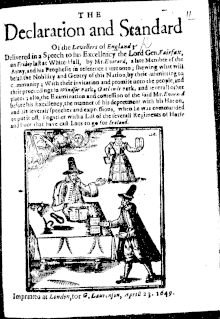Diggers
The followers of a Christian early communist dissenting movement in England founded by Gerrard Winstanley in 1648 were referred to as diggers ( English “diggers”) . They represented a radical split from the Levellers and therefore called themselves True Levellers . According to their interpretation of a passage from the Acts of the Apostles of Luke ( Acts 4,32 EU ) they stood up for a new social order based on common property should be based on the extensive leveling of differences in ownership and an agrarian way of life in small, rural communities.
history
At the end of the English Civil War (1642–1649) between the King and Parliament , conflicts broke out within the victorious parliamentary party. The majority of the members of the lower house tried to enforce a uniform Presbyterian church order with the involvement of the defeated King Charles I. This met with resistance from large parts of the parliamentary army. Officers and men, in particular Oliver Cromwell himself, of the New Model Army tended to congregationalism in religious matters , which provided for extensive autonomy for the parishes. Unlike the leaders of the army, many common soldiers were politically close to the early democratic levelers, who advocated equal suffrage for all free men. In order to take the lead from this movement and at the same time prevent the king from pitting army and parliament against each other, Oliver Cromwell and the leaders of the parliamentary army carried out the condemnation and execution of Charles I, which took place on January 30, 1649. Under the name Commonwealth of England , the country was declared a republic, in which a council of state took over the role of king. The elite of the republic, like Cromwell himself, mostly came from the gentry , the lower landed gentry. The ideas of the Levellers and even more of the more radical True Levellers went decidedly too far for this layer. Both belonged to a large number of groups who tried to realize their ideas in this time of political turmoil.
Winstanley and fifteen colleagues published a manifesto in which they called themselves True Levellers to differentiate themselves from the levelers who only advocated political, but not economic, equality. Winstanley and his followers subsequently occupied and cultivated public land. In April 1649 around St George's Hill in Weybridge , Surrey . They distributed the proceeds of their work to the needy, as they also wanted to abolish trade and the money economy. In this way they promoted extensive land reform and the idea of common ownership. After starting to translate their ideas into action in local communities in Wales and England, they became known as "Diggers" by supporters and opponents alike. In their beliefs, democratic , and to some extent anarchist, aspects played an essential role. They assumed that the ruling class would disappear as soon as all Englishmen lived together in independent communes. They would then either be forced to join the municipalities or go under. Digger communities were formed all over England and Wales from 1649 onwards, but these were broken up again by 1651. It was mostly the local nobles who were responsible for this, endorsed by the Commonwealth Council of State.
Assessment from today's perspective
According to Hans-Christoph Schröder , the Diggers “criticized the system in a comprehensive way that included the socio-economic basis of society by calling the institution of private property and the system of 'buying and selling' the root of all evils and making them the target of their attacks.” The author Matthias Rude writes: “Within the dissenter movements, the most progressive ideas of the time are circulating - in addition to vegetarianism, in some communities this is also the equality of women and a nude culture. According to their leader Gerrard Winstanley (1609–1676) in 1649, there are 'tender hearts' among the True Levellers , which it pains to see how cows are beaten by the landlords' managers. This kind of solidarity with animals and the vegetarianism resulting from it [...] is an expression of political and religious dissidence in England in the 17th century, and in some currents an integral part of revolutionary endeavors. "
further reading
- Lewis H. Berens: The Digger Movement in the Days of the Commonwealth as revealed in the Writings of Gerrard Winstanley, the Digger, Mystic and Rationalist, Communist and Social Reformer. Simpkin, Marshall, Hamilton, Kent & Co. Ltd., London 1906, ( digitized version ).
- Klaus Deppermann: The free community of true equalizers. Gerrard Winstanley and the Digger rural communes. In: Hans-Jürgen Goertz (Ed.): Everything belongs to everyone. The community of goods experiment from the 16th century to the present day (= Beck's black series. 289). Beck, Munich 1984, ISBN 3-406-09289-6 , pp. 71-91.
- Gerrard Winstanley: Equality in the Realm of Freedom. Socio-philosophical pamphlets and tracts (= Reclam's Universal Library . 997). Edited and with an essay by Hermann Klenner . Translated from the English by Klaus Udo Szudra. Reclam, Leipzig 1983, (2nd, corrected edition, ibid 1986, ISBN 3-379-00005-1 ).
Musical reception
In the song The world turned upside down by Leon Rosselson, who u. a. interpreted by Dick Gaughan , the Diggers live on.
Web links
- Diggers in the Lexicon of Anarchy
Individual evidence
- ↑ 1642-1652: The Diggers and the Levellers. ( Memento of the original from March 4, 2006 in the Internet Archive ) Info: The archive link was automatically inserted and not yet checked. Please check the original and archive link according to the instructions and then remove this notice.
- ↑ Hans-Christoph Schröder: The revolutions of England in the 17th century (= edition suhrkamp . 1279 = NF 279). Suhrkamp, Frankfurt am Main 1986, ISBN 3-518-11279-1 , p. 213.
- ^ Matthias Rude: Antispeciesism. The liberation of humans and animals in the animal rights movement and the left. Butterfly Verlag, Stuttgart 2013, ISBN 978-3-89657-670-5 , p. 36.
- ↑ https://www.youtube.com/watch?v=XWzzvnPOyTM The world turned upside down
